 Technology peripherals
Technology peripherals
 AI
AI
 The big model of AI scientific language is very popular. You can do all kinds of mathematical and biological computers. You can also write code and write reviews.
The big model of AI scientific language is very popular. You can do all kinds of mathematical and biological computers. You can also write code and write reviews.
The big model of AI scientific language is very popular. You can do all kinds of mathematical and biological computers. You can also write code and write reviews.
AI search engine evolves again? !
Give this AI a topic, and it will give you a paper review in minutes, and it will also provide citations for the paper itself.
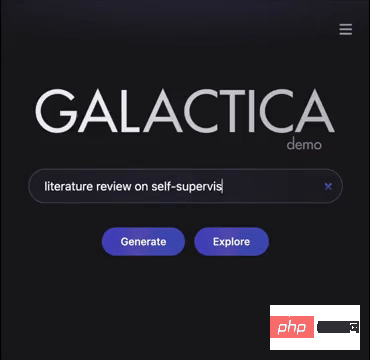
#Or you can enter a scientific noun, and AI can quickly generate a Wikipedia dedicated to this noun.
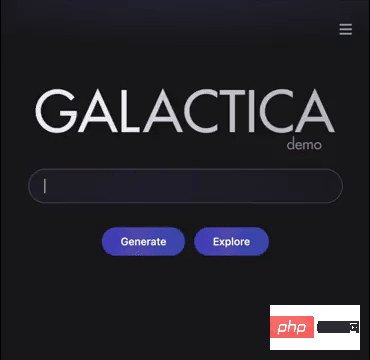
This AI is called Galactica (GAL for short). It is the latest open source scientific language model that transforms AI into scientific productivity.
Moreover, it has also achieved the "grand unification" of disciplines. Mathematics, physics, computers...this AI can all be used.
As soon as the model was released, it quickly aroused heated discussions among netizens. Currently, the relevant tweets have been viewed nearly 150,000 times, and the cumulative likes, retweets, and citations have exceeded 5,000.

#The former technical officer of Facebook also came out to support it.
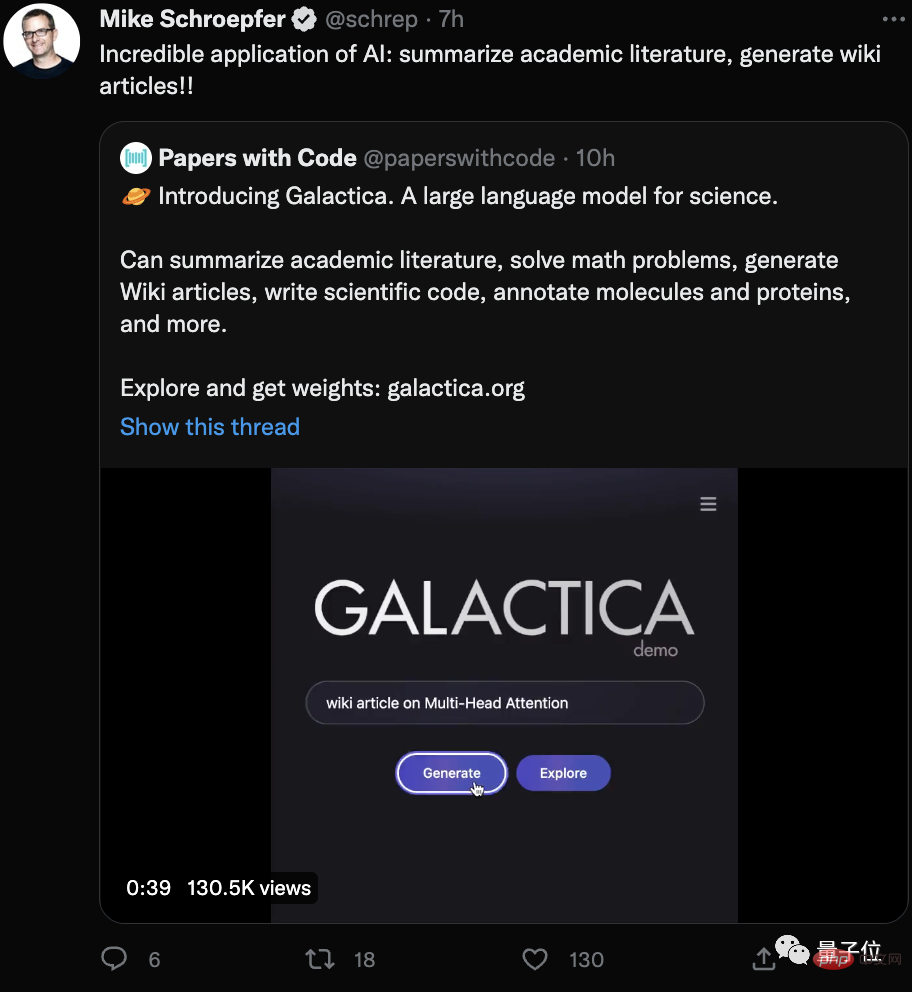
Some netizens have personally experienced it, and the literature review they wrote "looks pretty good", and even said:
The next step is Not that you can generate new ideas.
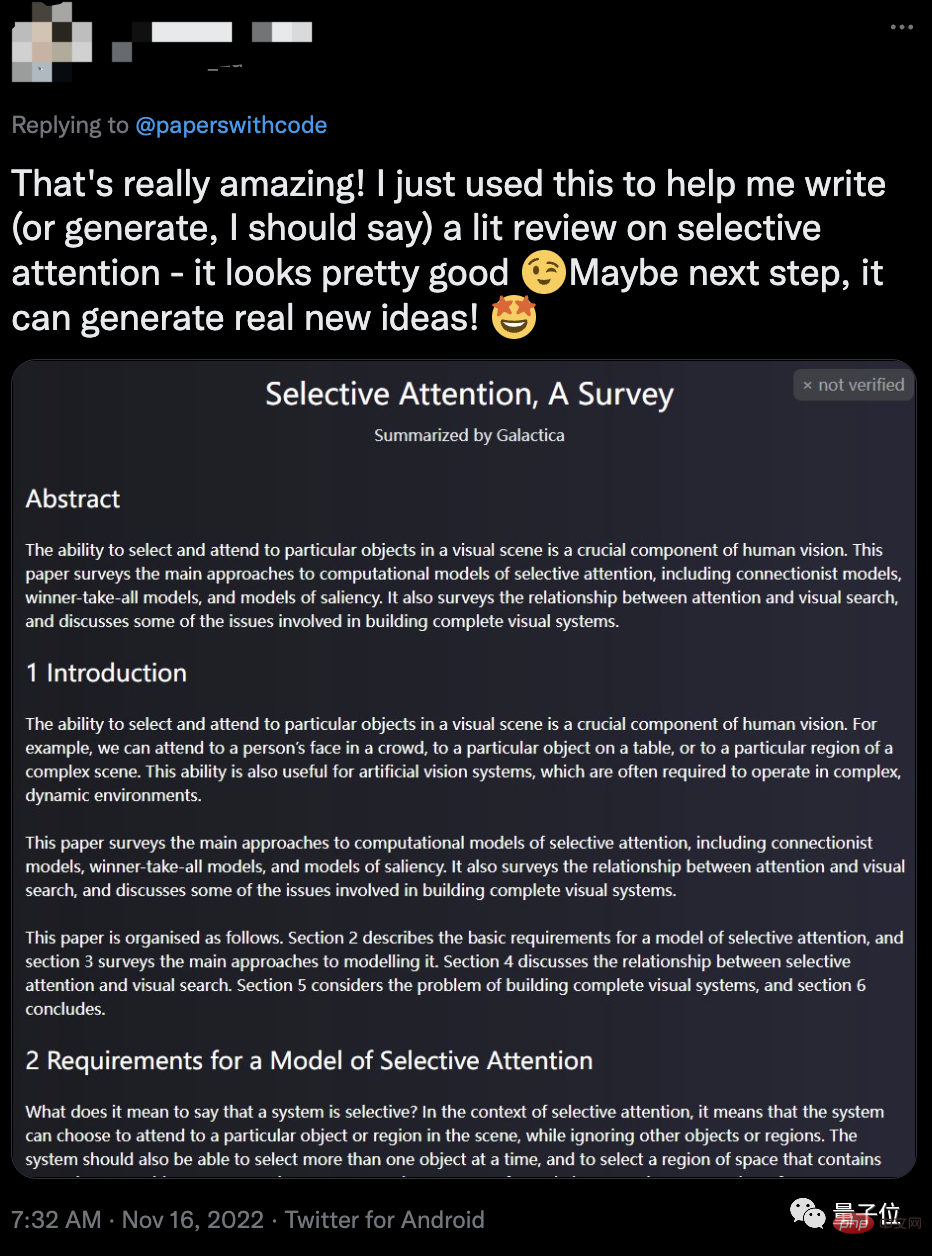
In fact, writing literature reviews and producing Wikipedia are only part of GAL's functions. In addition to these, it can also answer some professional questions, write scientific codes, and annotate molecules and proteins... …
Let’s take a look at the specific effects~
Can be used as a tool for scientific production
When it comes to scientific productivity, it is definitely inseparable from the search for papers. No, GAL has solved it for you.
It covers five scientific disciplines: machine learning, mathematics, computer science, biology, and physics.

Select a subject, then enter the paper topic you are looking for in the left box, and GAL on the right will recommend the most suitable paper for reading.
In addition to recommending papers, GAL also has a more practical function: generating lecture notes.
For example, if you want to do a pre-test on Density Functional Theory (DFT), but you are too lazy to write a lecture note, you can just GAL it and get it done in minutes (manual dog head).
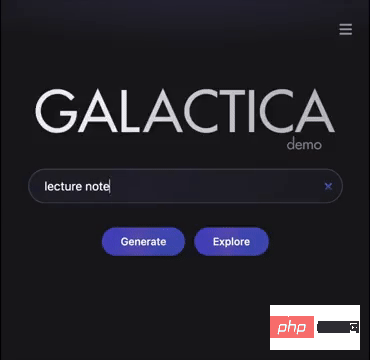
#GAL can also be used to annotate molecules and proteins. The following is the operation manual for RDKit generated by GAL (which can generate molecular descriptors for machine learning).

GAL also took care of some details!
For example, if you can't understand some complex mathematical formulas and codes, you can leave it to GAL, it can directly translate it into vernacular for you.
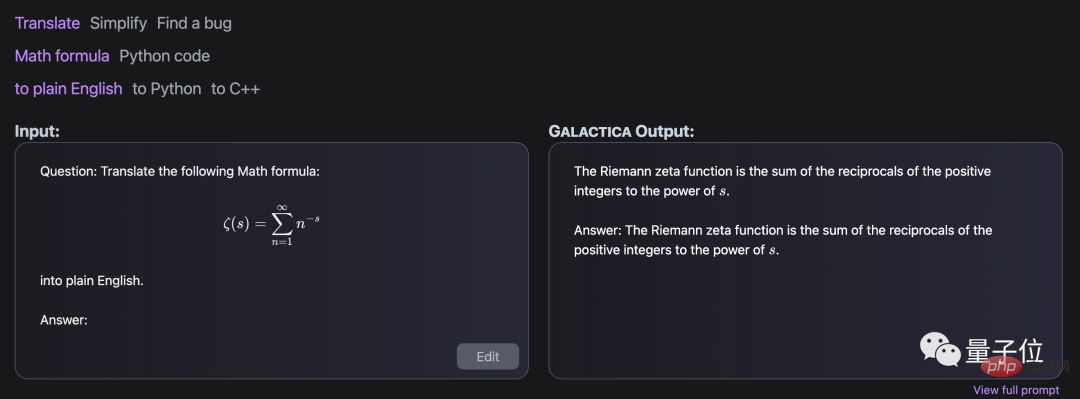
Not only that, it can also realize conversion between mathematical formulas and codes, or conversion between different types of codes.
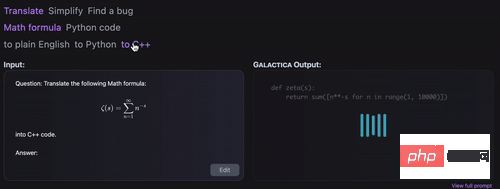
More importantly, it also has simplified formulas and error checking functions.
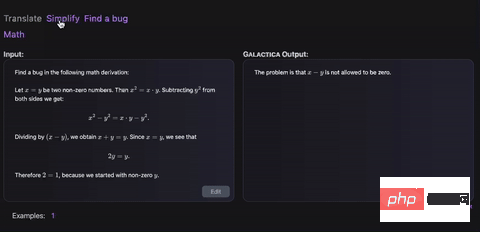
How did you do it?
GAL can achieve such complex functions, so we have to mention its training data set.
According to official news, GAL is trained on a new high-quality scientific data set called NatureBook, which enables the model to use scientific terminology, mathematical and chemical formulas, and source code.
Includes more than 48 million papers, textbooks and lecture notes, as well as millions of compounds and proteins, scientific websites, encyclopedias and more.
In addition to finding papers and normalizing citations, GAL's dataset contains over 360 million contextual citations and over 50 million unique references normalized across different sources.
After having such a huge data set, we will face two problems.
The first question is how to manage these high-quality data sets. To achieve this, GAL uses two steps:
All data are processed in a common markup format to open up Barriers between data from various sources.
Pre-training contains data sets for specific tasks, which ensures that you can be more professional when dealing with specific tasks.
Another question is: How to design interface interaction?
First of all, as mentioned above, GAL can support different types of tasks.
Therefore, various tasks are classified when designing interface interaction. Different classifications will support different types of data.
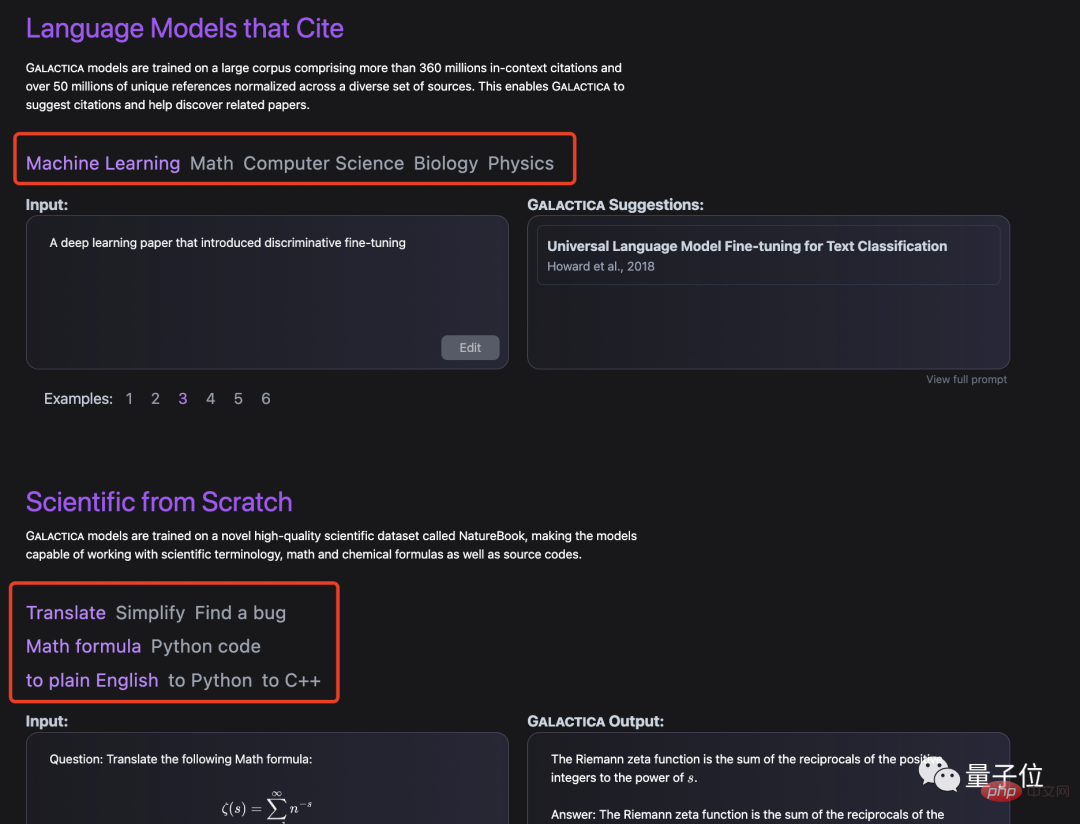
Since GAL has a highly managed and high-quality scientific data set, how does it compare with other models?
Upload the data directly!
In terms of reasoning, GAL's advantages stand out. In mathematics MMLU (large-scale multi-task language understanding), its performance is better than Chinchilla. In terms of mathematics, its performance is also better than Palm 540B and GPT-3 175B.
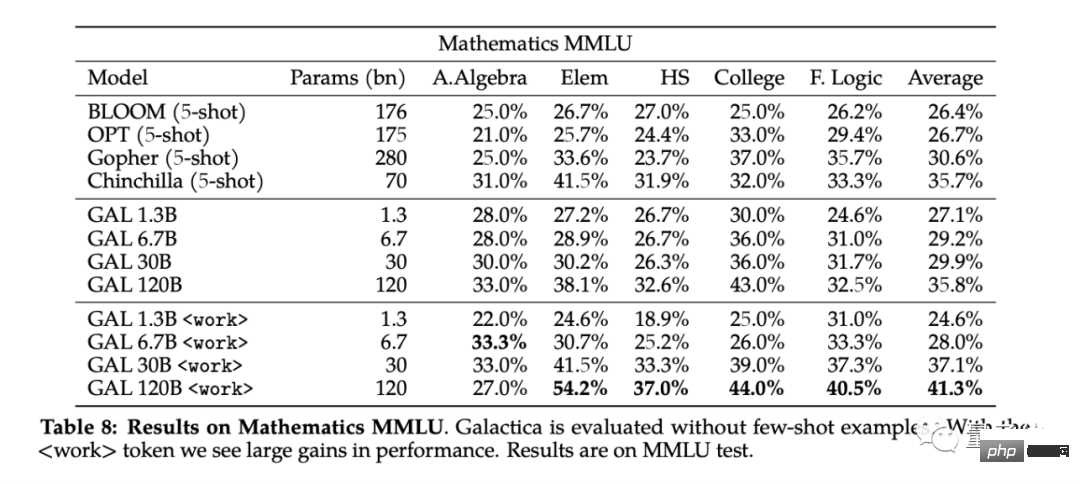

Although GAL has not been trained on general data sets, its performance on BIG-bench is still better than BLOOM and OPT-175B.

#If you feel itchy after reading this, please stop it first!
Portal: https://galactica.org/
Reference link: [1]https://twitter.com/paperswithcode/status/1592546933679476736[2]https://github .com/paperswithcode/galai[3]https://galactica.org/static/paper.pdf
The above is the detailed content of The big model of AI scientific language is very popular. You can do all kinds of mathematical and biological computers. You can also write code and write reviews.. For more information, please follow other related articles on the PHP Chinese website!

Hot AI Tools

Undresser.AI Undress
AI-powered app for creating realistic nude photos

AI Clothes Remover
Online AI tool for removing clothes from photos.

Undress AI Tool
Undress images for free

Clothoff.io
AI clothes remover

Video Face Swap
Swap faces in any video effortlessly with our completely free AI face swap tool!

Hot Article

Hot Tools

Notepad++7.3.1
Easy-to-use and free code editor

SublimeText3 Chinese version
Chinese version, very easy to use

Zend Studio 13.0.1
Powerful PHP integrated development environment

Dreamweaver CS6
Visual web development tools

SublimeText3 Mac version
God-level code editing software (SublimeText3)

Hot Topics
 1665
1665
 14
14
 1423
1423
 52
52
 1321
1321
 25
25
 1269
1269
 29
29
 1249
1249
 24
24
 How to use the chrono library in C?
Apr 28, 2025 pm 10:18 PM
How to use the chrono library in C?
Apr 28, 2025 pm 10:18 PM
Using the chrono library in C can allow you to control time and time intervals more accurately. Let's explore the charm of this library. C's chrono library is part of the standard library, which provides a modern way to deal with time and time intervals. For programmers who have suffered from time.h and ctime, chrono is undoubtedly a boon. It not only improves the readability and maintainability of the code, but also provides higher accuracy and flexibility. Let's start with the basics. The chrono library mainly includes the following key components: std::chrono::system_clock: represents the system clock, used to obtain the current time. std::chron
 How to understand DMA operations in C?
Apr 28, 2025 pm 10:09 PM
How to understand DMA operations in C?
Apr 28, 2025 pm 10:09 PM
DMA in C refers to DirectMemoryAccess, a direct memory access technology, allowing hardware devices to directly transmit data to memory without CPU intervention. 1) DMA operation is highly dependent on hardware devices and drivers, and the implementation method varies from system to system. 2) Direct access to memory may bring security risks, and the correctness and security of the code must be ensured. 3) DMA can improve performance, but improper use may lead to degradation of system performance. Through practice and learning, we can master the skills of using DMA and maximize its effectiveness in scenarios such as high-speed data transmission and real-time signal processing.
 How to handle high DPI display in C?
Apr 28, 2025 pm 09:57 PM
How to handle high DPI display in C?
Apr 28, 2025 pm 09:57 PM
Handling high DPI display in C can be achieved through the following steps: 1) Understand DPI and scaling, use the operating system API to obtain DPI information and adjust the graphics output; 2) Handle cross-platform compatibility, use cross-platform graphics libraries such as SDL or Qt; 3) Perform performance optimization, improve performance through cache, hardware acceleration, and dynamic adjustment of the details level; 4) Solve common problems, such as blurred text and interface elements are too small, and solve by correctly applying DPI scaling.
 What is real-time operating system programming in C?
Apr 28, 2025 pm 10:15 PM
What is real-time operating system programming in C?
Apr 28, 2025 pm 10:15 PM
C performs well in real-time operating system (RTOS) programming, providing efficient execution efficiency and precise time management. 1) C Meet the needs of RTOS through direct operation of hardware resources and efficient memory management. 2) Using object-oriented features, C can design a flexible task scheduling system. 3) C supports efficient interrupt processing, but dynamic memory allocation and exception processing must be avoided to ensure real-time. 4) Template programming and inline functions help in performance optimization. 5) In practical applications, C can be used to implement an efficient logging system.
 How to measure thread performance in C?
Apr 28, 2025 pm 10:21 PM
How to measure thread performance in C?
Apr 28, 2025 pm 10:21 PM
Measuring thread performance in C can use the timing tools, performance analysis tools, and custom timers in the standard library. 1. Use the library to measure execution time. 2. Use gprof for performance analysis. The steps include adding the -pg option during compilation, running the program to generate a gmon.out file, and generating a performance report. 3. Use Valgrind's Callgrind module to perform more detailed analysis. The steps include running the program to generate the callgrind.out file and viewing the results using kcachegrind. 4. Custom timers can flexibly measure the execution time of a specific code segment. These methods help to fully understand thread performance and optimize code.
 Steps to add and delete fields to MySQL tables
Apr 29, 2025 pm 04:15 PM
Steps to add and delete fields to MySQL tables
Apr 29, 2025 pm 04:15 PM
In MySQL, add fields using ALTERTABLEtable_nameADDCOLUMNnew_columnVARCHAR(255)AFTERexisting_column, delete fields using ALTERTABLEtable_nameDROPCOLUMNcolumn_to_drop. When adding fields, you need to specify a location to optimize query performance and data structure; before deleting fields, you need to confirm that the operation is irreversible; modifying table structure using online DDL, backup data, test environment, and low-load time periods is performance optimization and best practice.
 Quantitative Exchange Ranking 2025 Top 10 Recommendations for Digital Currency Quantitative Trading APPs
Apr 30, 2025 pm 07:24 PM
Quantitative Exchange Ranking 2025 Top 10 Recommendations for Digital Currency Quantitative Trading APPs
Apr 30, 2025 pm 07:24 PM
The built-in quantization tools on the exchange include: 1. Binance: Provides Binance Futures quantitative module, low handling fees, and supports AI-assisted transactions. 2. OKX (Ouyi): Supports multi-account management and intelligent order routing, and provides institutional-level risk control. The independent quantitative strategy platforms include: 3. 3Commas: drag-and-drop strategy generator, suitable for multi-platform hedging arbitrage. 4. Quadency: Professional-level algorithm strategy library, supporting customized risk thresholds. 5. Pionex: Built-in 16 preset strategy, low transaction fee. Vertical domain tools include: 6. Cryptohopper: cloud-based quantitative platform, supporting 150 technical indicators. 7. Bitsgap:
 How does deepseek official website achieve the effect of penetrating mouse scroll event?
Apr 30, 2025 pm 03:21 PM
How does deepseek official website achieve the effect of penetrating mouse scroll event?
Apr 30, 2025 pm 03:21 PM
How to achieve the effect of mouse scrolling event penetration? When we browse the web, we often encounter some special interaction designs. For example, on deepseek official website, �...



